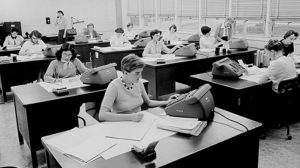 When we think of computers, most of us think of the modern day laptop, or even our smart phones, and when we think of who invented the computer, we think of a man, and that would probably be right, but when NASA thinks of computers, they also have to include the Women of NASA. They were known as “human computers” long before desktop, laptops, or even multi-function calculators existed. Barbara “Barby” Canright joined California’s Jet Propulsion Laboratory in 1939. She was the first female “human computer” and her job was to calculate anything from how many rockets were needed to make a plane airborne to what kind of rocket propellants were needed to propel a spacecraft. She did her calculations by hand, with only a pencil and graph paper. It often took more than a week to complete, and her work commonly filled six to eight notebooks with data and formulas. After the Japanese attack on Pearl Harbor, her work, along with that of her mostly male teammates, took on a new meaning. There was important work to be done to secure the safety of our nation. The army needed to lift a 14,000 pound bomber into the air, and Barby was responsible for determining the thrust-to-weight ratio and comparing the performance of engines under various conditions, so they could make that happen. Due to the amount of work it was going to take to accomplish this task, more “computers” were hired, including three women Melba Nea, Virginia Prettyman and Macie Roberts.
When we think of computers, most of us think of the modern day laptop, or even our smart phones, and when we think of who invented the computer, we think of a man, and that would probably be right, but when NASA thinks of computers, they also have to include the Women of NASA. They were known as “human computers” long before desktop, laptops, or even multi-function calculators existed. Barbara “Barby” Canright joined California’s Jet Propulsion Laboratory in 1939. She was the first female “human computer” and her job was to calculate anything from how many rockets were needed to make a plane airborne to what kind of rocket propellants were needed to propel a spacecraft. She did her calculations by hand, with only a pencil and graph paper. It often took more than a week to complete, and her work commonly filled six to eight notebooks with data and formulas. After the Japanese attack on Pearl Harbor, her work, along with that of her mostly male teammates, took on a new meaning. There was important work to be done to secure the safety of our nation. The army needed to lift a 14,000 pound bomber into the air, and Barby was responsible for determining the thrust-to-weight ratio and comparing the performance of engines under various conditions, so they could make that happen. Due to the amount of work it was going to take to accomplish this task, more “computers” were hired, including three women Melba Nea, Virginia Prettyman and Macie Roberts.
It was a time when women were mostly homemakers, and in fact, often looked at as probably not able to understand complicated things like math, science, and engineering, but times were changing. We were a nation at war, and many of the men were fighting. Not only did the women step up to the plate, but they showed that they could understand the work they did, as well as, if not better than their male counterparts. In fact, they did their work so well, that their calculations would end up charting the course of many ground breaking missions that would carry United States astronauts to the moon and beyond. These women were an elite team of mathematicians, engineers and scientists, who were tasked with turning numbers into meaningful data at what would later become NASA’s Jet Propulsion Laboratory and Langley Research Center. They challenged NASA to let them show what they could do, and when NASA did so, they really shined. It was an eye-opening accomplishment, and one that I’m pretty sure many men thought couldn’t be done.
It’s a funny thing, in my mind, that they were called “human computers” though. I suppose the work they did was computing, but the terminology just seems odd. These days, we talk about someone having the mind of a computer, but we don’t call them a computer. I guess that’s because we have computers, and no one would think of a person in that way. The reality is that, while these women were breaking ground in previously uncharted territory, their services would never really become unnecessary. In fact, one of the earliest human computers still works at Jet Propulsion Laboratory. Sue Finley is 80 now, and NASA’s longest serving female employee. She was originally hired in 1958 to work on trajectory computations for rocket launches, and is now  a software tester and subsystem engineer. She is currently working on NASA’s mission to Jupiter. Her legacy, and that of the other early human computers, is literally written in the stars. What really amazes me is that many people over 70 have no idea how to work a computer, and yet here is this 80 year old woman who is a software tester and subsystem engineer. Amazing!! Totally amazing!!
a software tester and subsystem engineer. She is currently working on NASA’s mission to Jupiter. Her legacy, and that of the other early human computers, is literally written in the stars. What really amazes me is that many people over 70 have no idea how to work a computer, and yet here is this 80 year old woman who is a software tester and subsystem engineer. Amazing!! Totally amazing!!


Leave a Reply